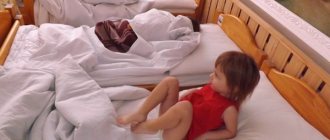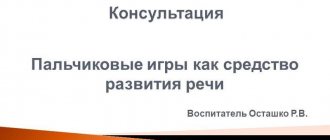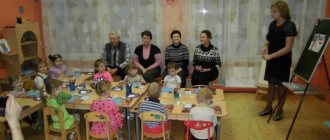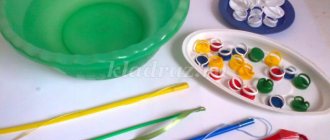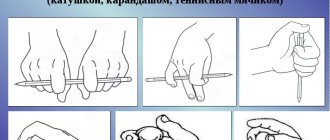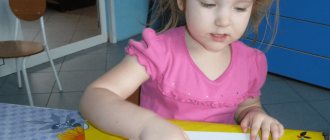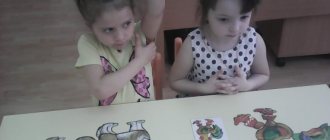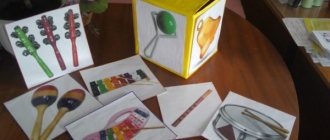In the lower grades, special attention is paid to the development of children's fine motor skills, imagination, and thinking. Gymnastics for fingers in elementary school helps the hands become obedient, which is necessary for performing precise movements in the visual arts and writing. By repeating the teacher’s movements, students activate their motor skills, develop the ability to concentrate and control movements. Before starting activities that parents can easily conduct even at home with a 7-8 year old child, it is recommended to study all the features and rules of exciting lessons.
Finger gymnastics for primary school
Finger games, which are so popular with children aged 7-8, are an activity that can significantly improve their skills. Scientists have found that hand movements are directly related to the cerebral cortex, which promotes development.
In elementary school, finger exercises are a prerequisite that allows children to take a break from unusual workload, get a boost of energy, and relax. There are many exercises that are complemented by funny rhymes, even songs that have a certain meaning - they contribute to the development of speech, a sense of rhythm, and vocabulary.
Despite the benefits of finger exercises, you should also not overuse interesting games. The duration of one lesson should not exceed a quarter of an hour, and it is better to start with short lessons - just a few minutes.
Preparing and conducting finger gymnastics classes at a preschool educational institution
To perform finger and hand gymnastics for children, no special materials are required.
Card index of games on life safety for senior and preparatory groups according to the Federal State Educational Standard
Note! The specialist selects exercises based on the age and development level of the group.
Children of the nursery group aged 2-3 years play “animals”, imitating the flapping of the wings of birds or the habits of familiar animals (dog, cat, bear, cockerel, cow). In this case, the teacher first shows the exercises individually, correcting and correcting each one. When this stage is passed, all the studied material is repeated in subgroups.
At the age of 3-4 years, the study of movements that strengthen the hands begins. To do this, tasks are given to depict familiar objects, such as a castle, a hammer, a flower.
4-5 year old children (pupils of the middle group) study both static and dynamic exercises. Gymnastics for fingers in kindergarten is carried out following the example of the teacher, and then the image begins to be modified (the gate opened - the gate closed).
At 5-6 years old (older group), the teacher no longer shows movements, children learn to perceive tasks by ear and reproduce them.
Note! By the sixth year of life, children are happy to organize impromptu “classes” for younger children, based on the exercises they have learned.
By the age of 6-7 years, classes take on the format of an imagination game. Taking an already familiar position, the child must tell the story associated with it, and also modify the position of his hands during his speech. At the age of six, a child, possessing a remarkable imagination, is able not only to retell a story familiar to him, but also to build his own, relying on visual material.
Approximate time plan for finger gymnastics in different age groups
Following the rules of the Federal State Educational Standard, the timing of finger gymnastics in groups of different ages is different. Class time is counted including warm-up and cool-down:
- 5 minutes - for younger preschoolers (2-4 years). In this case: 1 minute for warming up, 2 - for learning a new game, 1 - for repeating the old one, 1 - for massage with special balls.
- 7-9 minutes - for older preschoolers (5-7 years old). In this case: 1 minute for warming up, 1 - for performing static exercises, 2 - for conducting 2 dynamic games, united by a common theme, from 3 to 5 minutes for performing “finger theater”.
What is it for?
The main goal of finger exercises is to develop fine motor skills. With regular exercise, the benefits for children are undoubted, because at the same time they improve:
- accuracy and dexterity;
- fantasy, thinking;
- memory, speech;
- concentration of attention;
- Creative skills.
Exercises in grade 2 also allow students to take a break from prolonged drawing and writing. Simple hand movements relieve muscle tissue fatigue and prevent finger spasms, which often happens in children whose hands are not accustomed to prolonged stress.
Development of the project “Finger games” in kindergarten
Project activity in an educational institution involves an in-depth study of a topic or methodology. The project must be innovative - aimed at obtaining new information, and be useful to the project participants (children), the leader (teacher) and his colleagues.
Finger gymnastics is a broad topic. To develop a project, it is recommended to take one of the areas of developmental methodology. Examples of topics for finger gymnastics projects in kindergarten:
- "Russian folk finger games";
- “English finger games” (for a foreign language club in senior and preparatory groups);
- “Su-jok massage in finger gymnastics”;
- “Conjugate gymnastics in a speech therapy group” (for children with speech disorders);
- “Finger exercises and preparation for learning to write”;
- “Finger games as a means of early childhood development”;
- "Finger Theater: Tales at Your Fingertips";
- “Non-traditional finger gymnastics: games with equipment made from waste material.”
As part of the project activities, practical classes are carried out: the guys do finger gymnastics
The teacher describes in detail the methodological basis of the project activity and attaches a work plan. During the implementation of the project, he records the results of the exercises and the successes of the students. It is recommended to take photographs and videos of classes and leisure activities within the framework of the project.
The finger games project is revealed in theoretical and practical types of work
The documentary support of the project records:
- Topic of the project, timing, participants.
- The problem and its relevance.
- Goals and objectives.
- Theoretical basis:
- methodological articles and monographs on the topic;
- links to case studies;
- colleagues' experience.
- A long-term plan for mastering finger games.
- Schedule and content of consultations/master classes for parents.
- Summary of the reporting event.
- Applications (added as the project progresses): monitoring results, reports on open classes, etc.
The implementation of the finger games project implies the mandatory involvement of parents in working with children in a given direction
The project reporting event takes the form of an open lesson or leisure activity. Together with the music director, the teacher can prepare a festival of finger games. Or it will be a performance in a finger theater. Parents, methodologists, colleagues, young professionals and students of pedagogical colleges/universities are invited as guests.
As a reporting event, the children can prepare a performance in a finger theater
Table: fragment of the project “Conjugate gymnastics, or Theater of fingers and tongue”
| Author | Simonova S., teacher of MBDOU D/s No. 16 “Rainbow”, Petrovsk, Saratov region. |
| Novelty | Non-traditional forms of finger and articulation gymnastics using gaming technologies and visual aids in classes with preschoolers have been developed, improved and combined. |
| Target | Increase children's speech activity. |
| Participants |
|
| Project implementation timeframe | 1 year. |
| Implementation stages |
|
| conclusions |
|
| Quote from: https://www.maam.ru/detskijsad/proekt-soprjazhenaja-gimnastika-ili-teatr-palchikov-i-jazyka.html | |
Exercises
Teachers should remember that it is better to start with one or two exercises, allowing the child to learn the characteristics of each movement. It is recommended to conduct activities before and after class.
"Ring"
Finger movements allow you to relax tired muscles, rest, and improve motor skills.
Step-by-step exercise:
- Connect the thumb with the others.
- Be sure to ensure that even “rings” are formed.
- Carry out the exercise alternately on one and the other hand.
- Connect the fingers of both hands at the same time.
During the lesson, you can say any counting rhyme - this helps the child develop rhythm.
“Fist, palm, rib”
Another set of gymnastic movements that contributes to the development of primary school students.
Carrying out:
- Clench your fists and lightly tap on the surface of the desk.
- Unclench your fists and tap on the desk with the edge of your palm.
- Change the position of your hand and tap the surface with your palms.
It is not recommended to make sharp jerks - relaxing, smooth movements of the hands will bring benefits.
"Noughts and Crosses"
You can turn a simple activity into a fun game for children. The main thing is to understand that a zero is crossed fingers (middle finger with index finger). Zero - connected pads of the thumbs and ring fingers.
Now the children just have to follow the teacher’s commands and reproduce the necessary figures. You can even have a competition to see who can respond first and draw a cross or a zero. Over time, complicate the exercise - alternate the ring and middle fingers, start with movements of the left or right hand, finish with both at the same time.
"Fish"
Putting your palms together is a nimble “fish” that moves at the teacher’s command. Move your hands up and down, forward and return to the starting position. You can simultaneously make tilts and turns in different directions, because the fish do not move in one direction.
Light warm-up
It is recommended to complete the set of exercises with a light warm-up. Children can play “okay”, alternately clench and unclench their fingers, holding their arms suspended, or simply shake their hands, pretending to be a fan.
Finger gymnastics for younger schoolchildren
Finger gymnastics for primary schoolchildren It is no longer a secret to anyone that the level of development of a child’s speech is directly dependent on the degree of formation of fine movements of the fingers of their hands, namely fine motor skills. However, finger gymnastics does not lose its relevance for children 6-7 years old. The fact is that even just holding the pen correctly is not easy. Not to mention bringing out various hooks and sticks. So, we develop speech, memory and attention in the youngest schoolchildren. The exercises proposed below improve mental activity, promote memorization, and improve the writing process.
! You need to work with your child every day at any time, but not before bedtime. Perform all exercises vigorously, otherwise the training will not bring any effect.
1. “Rings” Alternately connect the pad of each finger with the thumb, forming a ring. First on the right, then on the left. And at the end of the lesson - synchronized movements on both hands. One, two, three, four, five, the fingers went out for a walk. One, two, three, four, five, Let's count our fingers. 2. “Horns” Close your big, middle and ring fingers into a ring. Stretch the rest to the sides as much as possible (make a goat). After this, close the thumb, ring finger and little finger into a ring (make “horns”). Repeat these shapes 3 times with each hand.
3. “Fist-edge-palm” Three positions on the table plane. Fist, then palm edge-on on the table, palm straight on the table. Do it with your right hand, left hand, then synchronously.
4. “Tic-tac-toe” Hook your middle finger over your index finger - a cross. Then connect the pads of the index finger and thumb - a zero. Alternate these movements.
5. “Mirror drawing” Take a pencil in each hand and simultaneously draw mirror-symmetrical figures and letters.
6. “Ear-nose” With your left hand, grab the tip of your nose, and with your right hand, grab the opposite ear. Let go, clap your hands and reverse the position of your hands.
7. “Fish” Put your palms together - this is a “fish”. Move the “fish” in different directions, simulating swimming.
8. “Snake” Clasp your palms together - this is the head of the “snake”. Press your hands together. Move the “snake” in different directions, simulating crawling.
9. “Castle” The poem should not be read very quickly, but clearly and rhythmically, so that the child’s movements coincide with the rhythm. Especially highlight the final “opened” so that the child can demonstrate how wide he opened the lock. Clasp your fingers into the lock and, shaking the “lock,” rhythmically say: “There’s a lock hanging on the door. Who could open it?” - Knocked, knocked, (without releasing the fingers, tap the bases of the palms against each other), - Twisted, circled (without disengaging the fingers, pull one hand towards you, the other away from you, alternately changing them), - Pulled, pulled (pull the handles in different sides, straightening your fingers, but not releasing the lock completely), - And they opened it! (sharply release your fingers, spread your arms wide to the sides).
10. “Eights” Draw a figure eight in the air with the index and middle fingers of the left and right hands, then synchronously.
11. A variety of object-based activities that develop fine motor skills: fastening and unfastening buttons, lacing shoes, games with mosaics, construction sets, puzzles; games with beans and peas (put them in different boxes).
12. Place your palms in front of your chest. The left palm slides up, the fingers of the left hand clasp the fingers of the right hand and squeeze them tightly. The same must be done with your right hand. Repeat 20 times.
13. Firmly clench both hands into fists, and then forcefully spread your fingers to the sides. Repeat 10 times.
14. Place your palms on the table and drum your fingers on the table. Let the child pretend that he is playing the piano. Now you need to hit the table with each finger 5 times. The child must learn to control each finger individually.
15. It is easy to clench both hands into fists and slowly rotate your hands. Then shake the brushes. Repeat 8 times in each direction.
16. Massage each finger from the nail phalanx down the finger and along the palm along the bones. If it’s difficult for a child and his hands get tired quickly, help your baby do this exercise. Massage your hands for 1-2 minutes.
17. Stand up, close your eyes, spread your arms to the sides. Touch the tip of your nose with the index finger of your right hand, then your left. Repeat the exercise 10 times, then shake your hands.
18. Stand up, close your eyes, spread your arms to the sides. Touch your left earlobe with your right hand (hand in front of your face), then touch your left earlobe again with your right hand (hand behind your head). Do the same with your left hand. Repeat the exercise 10 times in each direction, then shake your hands.
19. It’s better to give your child a pencil with edges.
I roll the pencil in my hands and twirl it between my fingers. I will certainly teach every finger to be obedient.
20. Helper pour different grains on the table - let the child try to identify and name the grains without looking
I'm sorting through the grains, I want to help Mommy. With my eyes closed, I can tell the difference between rice and buckwheat.
21. Nuts : take 2 walnuts or balls of similar size
I learned to hold two nuts between my fingers. This will help me write straight letters at school.
End of form
Adviсe
There are some useful tips that will help you get the most out of your classes and avoid unwanted mistakes. Be sure to take into account the following requirements and recommendations in each lesson:
- Before the lesson, make sure that the child’s hands are warm, if necessary, do a warm-up - rub your palms, straighten or bend your fingers;
- if the exercises are combined with a poetic text, you should not rush to read - pronounce the words at a slow pace;
- after mastering the pace, begin gradual acceleration;
- It’s better not to rush into updating your repertoire – 3-5 different games are enough;
- If the child is tired, stop the lesson immediately.
Another important rule is to choose games that require the participation of the little fingers, which are usually inferior in mobility to other fingers.
Finger warm-up is a useful and exciting activity for children that allows them to achieve positive results in the development of many skills. The main thing is not to force the child - if for any reason he refuses to repeat the exercise, it is better to abandon the lessons for a while. Otherwise, the student’s desire to continue will quickly disappear, and useful activities will become an unpleasant burden and a waste of time for him.
in winter
Fluffy snow lay on the branches. (we depict trees with our hands: we bend our elbows and raise them high, we spread our fingers, depicting the branches of a tree )
And all the kids run for a walk.
(the index and middle fingers of both hands “run” along the table like legs )
They sculpt a woman under the window (we make “rings” with the right and left hands and place them one above the other
)
They roll a snowball together.
(connect the tips of your fingers so that you get “balls” )
Skis, (slide your palms back and forth across the table
)
Sledge (put your palms on the table close to each other and make synchronized movements back and forth
)
And skates (put your palms on the edge and slide them back and forth on the table in antiphase
)
They race.
Source: instagram @undeuxtroismag


